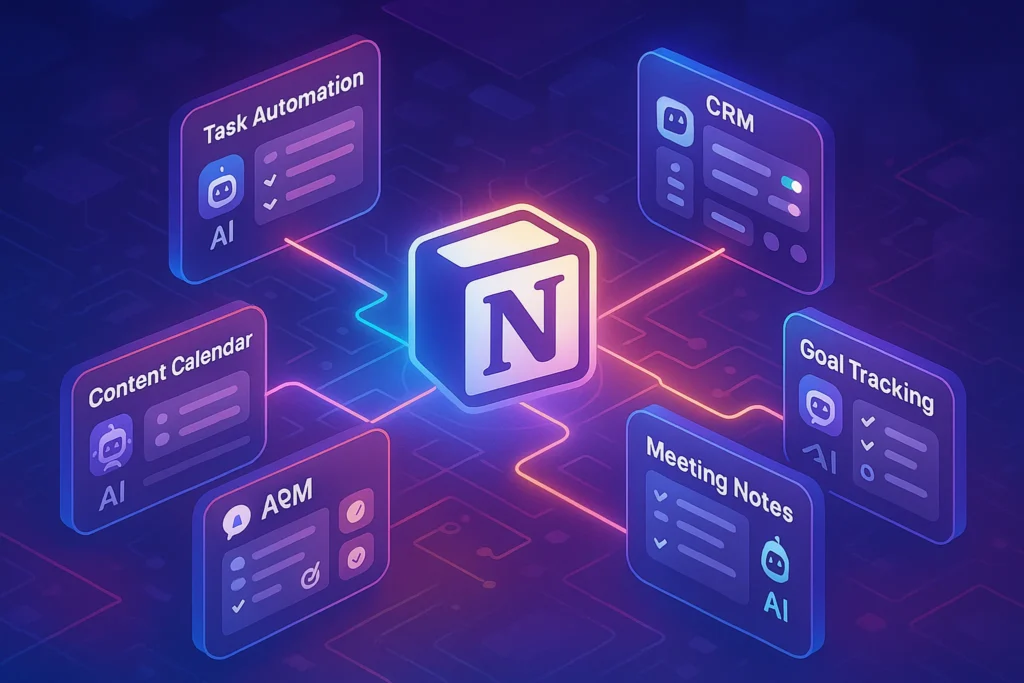📒 Intro
Why do so many productivity systems fail? It’s not because the apps are bad or the goals are unrealistic. It’s because there’s no weekly reset. A proper weekly review acts like a pilot’s checklist: it prevents drift, catches problems early, and ensures you’re still flying toward your intended destination. Without this ritual, even the smartest productivity setup will eventually collapse under chaos.
This playbook shows you how to create a weekly review that combines rituals (the human side), dashboards (the system side), and metrics (the feedback loop). It’s not about adding more tasks—it’s about creating the mental clarity to focus on what matters most.
💡 Nerd Tip: Weekly reviews are less about looking backward and more about re-aligning forward. Think of them as your reset button for momentum.
🧭 Why Weekly Review Matters
Life without review drifts. One week you’re aligned with your goals, the next you’re buried in tasks that don’t move the needle. Weekly reviews stop drift before it compounds. They create a moment for reflection, allow for small adjustments, and restore a sense of control.
Psychologists have found that reflection boosts long-term learning and performance by up to 23% compared to non-reflective work. That’s because when you pause and look back, you understand patterns instead of just reacting. A weekly review provides exactly this pause.
Without it, you risk the “productivity paradox”: getting busier, checking boxes, and yet feeling further from your goals. With it, you can align tasks with strategy, track both wins and losses, and move into the next week with clarity.
If you’ve ever read about the ultimate guide to building a second brain, you’ll know that knowledge systems only work if you revisit and refine them. The weekly review is where that refinement happens.
🔮 Part 1: Rituals (The Human Side)
Rituals anchor the weekly review in consistency and meaning. Choose a fixed time—Friday afternoon, Sunday night, or any slot you can protect. By repeating it weekly, you train your brain to expect closure and reset at that moment.
Build an environment that encourages reflection: a calm corner, a favorite drink, or even a particular playlist. These cues signal your brain it’s time to shift gears. Writers often say they light a candle or open the same notebook every review; the repetition conditions focus.
Your ritual should cover three essentials:
-
Look back: Review your calendar, tasks, and notes from the past week. See where your energy actually went.
-
Record gratitude: Write down wins, no matter how small. This balances your perspective.
-
Reset inputs: Clear inboxes, check loose notes, and decide what gets carried forward.
Creators and entrepreneurs who do this often report a deeper sense of psychological safety: they know everything has been seen, processed, and logged. Instead of worrying about what they might be forgetting, they enjoy a clear horizon.
💡 Nerd Tip: Rituals aren’t about being fancy—they’re about being repeatable. A cup of tea and 30 minutes of quiet beats a complicated system you’ll abandon.
📊 Part 2: Dashboards (The System Side)
Once the ritual creates the space, dashboards provide the visibility. A dashboard is simply a curated set of views—your personal cockpit. It doesn’t have to be software-heavy; a notebook or whiteboard can be just as effective.
Creators often use three types of dashboards:
-
Task Dashboard: Shows what was completed, what’s pending, and what’s blocked. Tools like Todoist, Notion, or even Google Sheets work here.
-
Calendar Dashboard: Offers a snapshot of the week ahead. Seeing key events alongside deadlines prevents double-booking and overload.
-
Habit Dashboard: Tracks streaks and consistency. Whether it’s daily writing, gym sessions, or hours of deep work, this dashboard keeps habits visible.
Modern tools like Notion or Obsidian allow you to create integrated dashboards where tasks, events, and habits live together. If you prefer lightweight setups, even a color-coded spreadsheet can be powerful.
The key isn’t design—it’s relevance. Dashboards should show you exactly what you need to know in 5 minutes. Anything more and you risk data overload.
For inspiration, check out how to set up a productivity system that actually works. The weekly review is where that system stays alive.
📈 Part 3: Metrics (The Feedback Loop)
Dashboards show the status; metrics show the meaning. The biggest mistake in productivity is tracking too much. A good weekly review uses no more than five key metrics.
-
Output metrics: tangible results like posts published, videos recorded, or revenue generated.
-
Input metrics: effort drivers like hours of deep work, sleep quality, or workouts completed.
-
Qualitative metrics: softer signals like mood, energy, or stress rating.
Imagine a creator tracking: three blog posts published, 18 hours of deep work, and average mood score of 7/10. Those numbers tell a story. If output is slipping while input is steady, maybe motivation is waning. If both input and output are up but mood is down, you’re pushing too hard.
By combining these signals, you get a weekly feedback loop that helps you correct before burnout or stagnation. It’s the same principle athletes use: monitor load and recovery, not just performance.
💡 Nerd Tip: Choose one output, one input, and one mood metric. Three data points weekly can outperform 20 if you actually act on them.
🛠️ Implementation Steps (Step-by-Step)
-
Pick a fixed time and ritual. Commit to a weekly slot, no matter how small.
-
Create your dashboard. Start simple: one page in Notion or one tab in Google Sheets.
-
Select 3–5 KPIs. Keep them balanced across input, output, and qualitative.
-
Review the past week. List successes, misses, and lessons. This isn’t guilt—it’s insight.
-
Plan the next week. Assign top priorities, highlight key events, and align with rituals.
-
Commit to one micro-goal. Something so small it guarantees progress: one article, one gym session, one deep work block.
Within 4–6 weeks, this habit becomes autopilot. You’ll no longer wonder if you’re moving forward—you’ll see it in your review logs.
⚠️ Challenges & Fixes
Every system hits friction. Common obstacles include:
-
Forgetting reviews: Set recurring reminders in your calendar. Protect the slot like a meeting with your future self.
-
Making it bureaucratic: Keep it lean. If the review feels like another admin chore, you won’t stick to it.
-
Data overload: More metrics aren’t better. Choose what truly reflects progress and cut the rest.
Creators often fall into the trap of tracking everything because tools make it easy. But a wall of graphs won’t make you more productive—it will paralyze you. Remember, simplicity is sustainable.
💡 Nerd Tip: If your weekly review starts creeping past 90 minutes, strip it down. The goal is clarity, not complexity.
📊 Want a Ready-Made Weekly Review Dashboard?
Download our free Notion template and start tracking smarter this week. Simple, practical, and designed for creators who want clarity.
📂 Archive & Knowledge Capture
Weekly reviews often get trapped in the realm of tasks: what was done, what’s left, and what needs to be moved forward. But a review that ignores knowledge capture misses half the picture. Every week you encounter insights—whether from books, podcasts, meetings, or even mistakes. Unless these are archived into a trusted system, they vanish.
A practical approach is to dedicate part of your weekly ritual to feeding your “second brain.” That might mean moving quick notes into Notion, categorizing highlights in Obsidian, or tagging articles for future reference. The aim is to ensure your learnings don’t stay scattered across sticky notes and inboxes.
By treating your weekly review as a bridge between action and knowledge, you create a system where ideas compound. Instead of solving the same problem multiple times, you draw on a growing archive of lessons. For anyone inspired by the ultimate guide to building a second brain, this is where the theory turns into a practice you can sustain week by week.
💡 Nerd Tip: Add one line to your review template: “What did I learn this week that future me should not forget?” Answering it weekly creates compounding wisdom.
🧘 Energy & Mindset Check
Tasks and metrics are easy to quantify, but the human mind isn’t a spreadsheet. A powerful weekly review doesn’t just ask “What did I do?”—it also asks “How did I feel?”
Tracking energy, sleep quality, stress, or overall mood creates a richer dataset. For example, if you see productivity dip whenever sleep falls below six hours, you can intervene. Similarly, if burnout rises when social connections drop, you can intentionally plan rest or connection time.
Some creators score their weekly mood on a scale from 1–10, while others jot down three adjectives that describe their mental state. These small reflections surface patterns that pure output metrics would miss. The science backs it: mood-tracking has been shown to reduce stress and increase self-awareness, which in turn improves performance.
💡 Nerd Tip: Numbers are incomplete without feelings. Add a “Mood & Energy” line to your review. Over months, this graph tells a story no productivity app can.
📅 Monthly & Quarterly Link
Weekly reviews are powerful, but their real value comes when they connect to larger cycles. Think of them as puzzle pieces: each week is a snapshot, but the monthly and quarterly reviews show the full picture.
During your weekly review, flag trends worth revisiting at the end of the month. For example, if you consistently miss deep work sessions, note it as a recurring issue. When your monthly review comes, these notes give you evidence, not just memory. Similarly, quarterly reviews can aggregate metrics from your weekly logs to reveal progress toward yearly goals.
This linkage ensures your reviews don’t become isolated check-ins. Instead, they form a ladder: weekly steps leading up to monthly insights, which feed into quarterly adjustments. Without this structure, weekly reviews risk becoming repetitive instead of cumulative.
💡 Nerd Tip: Add one section at the end of your weekly review: “For Monthly Review.” Use it to log patterns or concerns to revisit at a higher zoom level.
🚨 Common Pitfalls in Weekly Reviews
Even the best review system can fail if misused. Creators often fall into predictable traps:
-
Overcomplication: Spending two hours on dashboards, drowning in graphs, and burning out. The goal is clarity, not a data science project.
-
Skipping lessons learned: Many write down tasks but never reflect on what worked or failed. Without lessons, reviews are bookkeeping, not growth.
-
Rigid perfectionism: Missing one week and abandoning the habit altogether. Sustainability comes from flexibility, not all-or-nothing thinking.
Stories abound of creators who overbuilt their review systems only to abandon them. One Reddit user wrote: “I spent weeks building a Notion dashboard so complex I stopped using it after three reviews.” Simplicity beats sophistication when it comes to rituals.
💡 Nerd Tip: If your review feels like an obligation, trim it. The best system is the one you’ll actually use 52 times a year.
🌍 Team & Collaboration Angle
Weekly reviews aren’t just for individuals—they can transform teams. In fact, many of the world’s most productive organizations run weekly “alignment meetings” that mirror the same principles: reflection, dashboards, and metrics.
For teams, dashboards often live in Notion, Linear, or Trello. Instead of personal habits, they track shared goals: project milestones, sprint velocity, or client deliverables. Team rituals might include a brief Friday sync where each member shares one win, one challenge, and one focus for the week ahead.
The benefits are huge. Transparency prevents duplicate work, alignment ensures everyone is moving in the same direction, and reflection builds trust. Even small creator teams—like a newsletter duo or YouTube crew—can use shared dashboards to amplify impact.
💡 Nerd Tip: If you work in a team, dedicate five minutes of your review to prep notes for a shared check-in. Your private reflection becomes fuel for collective clarity.
📬 Want More Productivity Playbooks?
Join our free newsletter and get weekly insights on productivity rituals, dashboards, and metrics—delivered by NerdChips straight to your inbox.
🔐 100% privacy. Just actionable systems and tools for creators and teams.
🧠 Nerd Verdict
Weekly reviews are the backbone of sustainable productivity. Without them, even the best apps and hacks drift into noise. By combining human rituals, simple dashboards, and focused metrics, you create a cycle of reflection and adjustment. That cycle builds clarity, momentum, and resilience.
For creators balancing multiple projects, or teams trying to align output with goals, this ritual is the one lever that multiplies the impact of every other tool.
❓ FAQ: Nerds Ask, We Answer
💬 Would You Bite?
If you could only review one metric each week, would you focus on output (completed work) or input (hours of deep work)?
Crafted by NerdChips for creators and professionals who believe reflection fuels progress.



